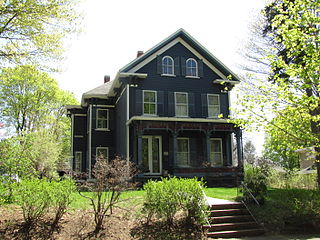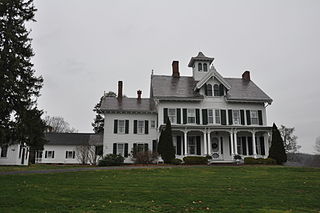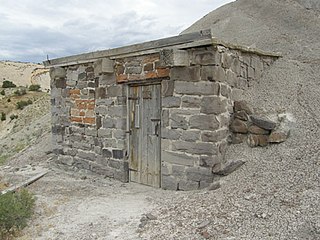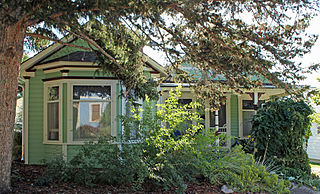
The John Tangeman House is a historic house in the city of Wyoming, Ohio, United States. The city's best house of its style, the residence was once home to a prosperous factory owner, and it has been named a historic site.

The Twin Sisters Lookout, also known as the Twin Sisters Radio Tower and the Twin Sisters Shelter Cabin, was built by the U.S. Forest Service in 1914, the year before the establishment of Rocky Mountain National Park. The rustic stone structure was taken over by the National Park Service in 1925. The one-story building has an arched roof with a trap door to provide access when snow has drifted over the ground-level door. From 1914 to 1969 the shelter served as accommodations for fire observation crews at a nearby frame lookout, which has since vanished. The building is now used as a radio repeater station.

15 Wave Avenue is a well-preserved Italianate style house in Wakefield, Massachusetts. It was built between 1875 and 1883, and was listed on the National Register of Historic Places on July 6, 1989.

Reservoir Park is a historic park on Boylston Street in Brookline, Massachusetts. Its principal feature is Brookline Reservoir, formerly an element of the public water supply for neighboring Boston. The reservoir was built in 1848 as the main terminus of the now-defunct Cochituate Aqueduct, which delivered water from Lake Cochituate in the western suburbs. The reservoir covers 21.1 acres (8.5 ha), and is roughly kidney-shaped. A gravel path extends around the perimeter of the reservoir. The park is bounded on the north by Boylston Street, on the west by Lee Street, on the south by Dudley Street, and on the east by Warren and Walnut Streets.

The Unitarian Church is a historic American church on Exeter Road in Hampton Falls, New Hampshire. Built in 1838, it is a rare example of an in antes Greek Revival temple front in the state, and is distinguished by the presence of Victorian trompe-l'œil panels and ribbing on its interior walls. The church was listed on the National Register of Historic Places in 1984. It is presently used for services in the summertime.

Dexter Universalist Church, or the First Universalist Church of Dexter, is a historic church on Church Street in Dexter, Maine. Built in the 1820s and restyled in the 1860s, it is a distinctive work of Boston, Massachusetts architect Thomas Silloway. The building was listed on the National Register of Historic Places in 1985.

Hillside, also known as the Charles Schuler House, is a mansion overlooking the Mississippi River on the east side of Davenport, Iowa, United States. It has been individually listed on the National Register of Historic Places since 1982, and on the Davenport Register of Historic Properties since 1992. In 1984 it was included as a contributing property in the Prospect Park Historic District.

The David Lyman II House, also known as the Lyman Homestead, is a historic house at 5 Lyman Road in Middlefield, Connecticut. Built around 1860, it is among the best Gothic Revival structures in the greater Middletown area. The house is built in part on the foundation of a 1785 house that originally stood on the site. The 2-acre (0.81 ha) property containing the house and its outbuildings was listed on the National Register of Historic Places in 1986.

The Rock House was built as a residence for the National Park Service custodian of Arches National Monument, now Arches National Park, in 1941. Constructed using Civilian Conservation Corps labor, the residence served its purpose until it was replaced by newer housing under the Park Service's Mission 66 program. The house is built of local stone in a coursed rubble pattern, with painted milled wood trim. The house was designed by Verland Norgard, in a style that combines rustic elements with Greek Revival and Federal style details. Two small, non-contributing additions have been constructed to the rear of the house, and the interior, which has been extensively modified, does not retain its historic integrity.

The Wild Basin Ranger Station is located in the southeastern portion of Rocky Mountain National Park, Colorado. Built in 1932, the ranger station is an example of National Park Service rustic architecture, built to plans by the National Park Service Branch of Plans and Design. The log structure is roofed with wood shingles and rests on a concrete foundation. The interior consists of three rooms, used for administrative and residential purposes.

The Denis Julien Inscription was left on a rock face in 1838 along the Green River in Moffat County, Colorado by Denis Julien, a French-American trapper who was one of the few Europeans in the area in the 1830s. Julien made a practice of leaving his mark on locations along the Green and Colorado rivers, leaving at least eight such marks. Four, including the Colorado mark, are listed on the National Register of Historic Places.

The Earl Douglass Workshop-Laboratory was used by Earl Douglass, the discoverer of the dinosaur bone deposits at the dinosaur quarry in Dinosaur National Monument, to preserve, study and prepare fossil specimens. Located next to the quarry adjacent to the Quarry Visitor Center, the workshop is a 10.5-foot (3.2 m) by 13.17-foot (4.01 m) stone shed with a flat soil roof, built into the hillside. It was built about 1920 by Carnegie Museum of Natural History personnel who were working at the site in eastern Utah.

The Roscoe Goose House is a historic house at 3012 South Third Street in Louisville, Kentucky. Built about 1891, it is a 2+1⁄2-story brick building with Italianate and later Victorian styling. It has a low-pitch hip roof with bracketed cornice, a wall dormer rising at the center of the front facade, a single-story porch that wraps across the front and around the left side, and a large arched window on the ground floor next to the main entrance. It was home to jockey Roscoe Goose from 1913 until about 1970.

Julian–Clark House, also known as the Julian Mansion, is a historic home located at Indianapolis, Marion County, Indiana. It was built in 1873, and is a 2+1⁄2-story, Italianate style brick dwelling. It has a low-pitched hipped roof with bracketed eaves and a full-width front porch. It features a two-story projecting bay and paired arched windows on the second story. From 1945 to 1973, the building housed Huff's Sanitarium.

The Andrew–Ryan House is a historic house located in Dubuque, Iowa, United States. This is considered the best example of the Second Empire style in the city, and one of finest in the state of Iowa. The two-story brick structure was designed by Dubuque architect Fridolin J. Herr Sr. It was originally built 13 feet (4.0 m) to the north, but was moved to its present location between 1885 and 1890. The porches on the south side may have been added at that time. The house is from the high Second Empire style and features a mansard roof, arched windows, dominant chimneys, a prominent belvedere, and classical moldings on the pilasters, belt courses, and stone work.

The Yewell House, at 630 Clay St. in Owensboro, Kentucky, was built in 1894. It is Queen Anne in style. It was listed on the National Register of Historic Places in 1986.

The Frank Latuda House, at 431 W. Colorado Ave. in Trinidad, Colorado, was built in 1925. It was listed on the National Register of Historic Places in 2010.

The Bridge over Burro Cañon, near Madrid, Colorado, was built in 1936. It carries Colorado State Highway 12, a main route linking La Veta with Trinidad, over an arroyo. It was listed on the National Register of Historic Places in 1985.

The Robinson House in Louisville, Colorado, at 301 Spruce, also known as the Cedarberg House, was built in 1904. It was listed on the National Register of Historic Places in 1986.

The Rhoades House, at 1024 Grant Ave. in Louisville, Colorado in Boulder County, Colorado, was built in 1906. It was listed on the National Register of Historic Places in 1986.





















